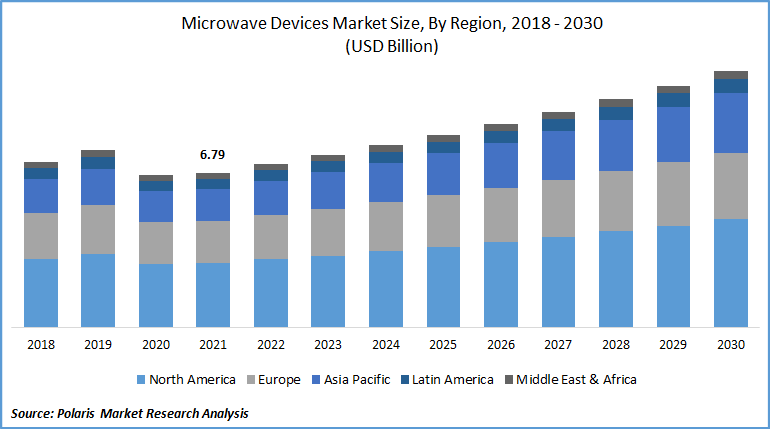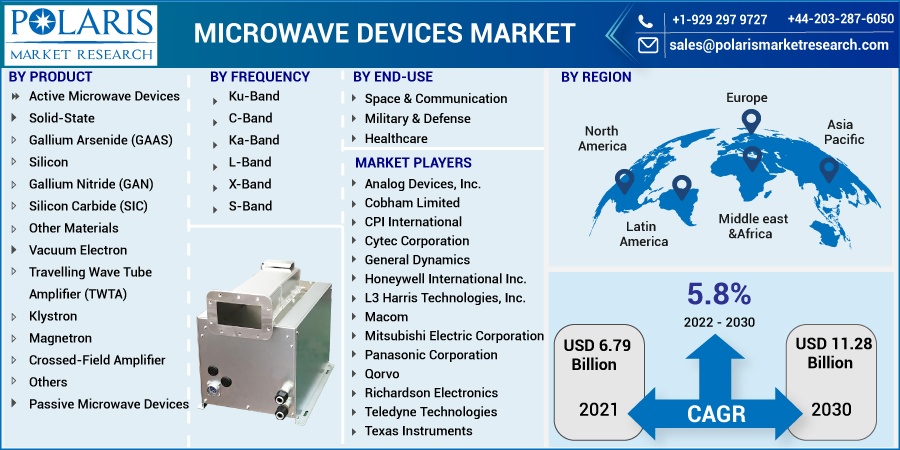
Microwave Devices Market Share, Size, Trends, Industry Analysis Report, By End-Use (Space & Communication, Military & Defense, Healthcare, Others); By Product; By Frequency; By Region; Segment Forecast, 2022 - 2030
- Published Date:Feb-2022
- Pages: 115
- Format: PDF
- Report ID: PM2310
- Base Year: 2021
- Historical Data: 2018 - 2020
Report Outlook
The global microwave devices market was valued at USD 6.79 billion in 2021 and is expected to grow at a CAGR of 5.8% during the forecast period. Rising demand for improved communication services to aid growth is driving the market growth during the forecast period. Demand for better communications services is rising, which will help the economy grow.

Know more about this report: request for sample pages
These devices use microwave links to offer point-to-point communication, allowing the end-user to receive the most information rapidly and securely. As a result, microwave lines are used by the army, NASA, and several other national security institutions to transport classified information within their organizations. The growing emphasis on military satellite launches to enhance the military communication network is driving market expansion in both developed and emerging countries.
The Advanced Extremely High-Frequency satellite series, for example, is a communication satellite series operated by the United States Space Force. This communication satellite is used to send secure information to air, land, and naval platforms via microwave equipment. Furthermore, increased adoption in the healthcare industry to aid the market growth of this technology use is likely to increase as the healthcare industry's research and development efforts expand.
Microwave tomography, a type of medical imaging that uses microwave technology, is now frequently employed. Ultra-wideband imaging is a well-known approach for cancer detection based on the enormous electrical contrast between malignant tumor tissue and surrounding normal bodily tissue. However, in electronic circuits, microwave devices are made up of active components such as transistors and tubes, as well as passive components such as isolators, resistors, and filters.
As a result, architectural intricacy makes it difficult to comprehend how microwave goods work, resulting in inefficient outcomes. Bulky electrical circuits also take a lot of energy to work efficiently and are slow to operate. Devices complexity is projected to be a key stumbling block in the adoption of these devices, given the rapid improvements in smartphone designs, cellular network needs, and the rising deployment of sophisticated combat equipment.
 Know more about this report: request for sample pages
Know more about this report: request for sample pages
Industry Dynamics
Growth Drivers
Players' initiatives including partnerships, product launches, acquisitions, geographical expansion, and intelligent decisions, are projected to accelerate the growth of the microwave devices market. For instance, in June 2021, Thales Group has created an L-band satellite solution product line. This series is designed to give you more mobility while yet providing the same benefits as Iridium. It has a built-in 802.11b/g Wi-Fi access point that supports multiple users.
In addition, in June 2021, “The RESON SeaBat T51-R Multi-beam Echo-sounder” from Teledyne Technologies provides products for water operations at the frequency of 800 kHz without sacrificing efficiency. Thus, major players' acquisitions and advancements are the factors that are boosting the market growth during the forecast period. Furthermore, in the medical industry, technological advancements are expected to enable the employment of advanced technologies, pushing the growth of the market.
To avoid nerve injury, this device uses a microwave that is targeted on the affected tissue and heated. These devices can also be used to remove undesirable tissue masses like tumors. Due to their short wavelengths, which limit excessive surface penetration and allow accurate ablations, they are commonly employed in medical applications. The devices are mostly used to treat uterine fibroids, malignancies, and corneal ablation.
Report Segmentation
The market is primarily segmented based on product, frequency, end-use, and region.
|
By Product |
By Frequency |
By End-Use |
By Region |
|
|
|
|
Know more about this report: request for sample pages
Insight by Frequency
The Ku-band segment is expected to be the most significant revenue contributor in the global market. The Ku-band (Ku stands for Kurz under) market segment covers the frequency range of 12 to 18 GHz in the mid-frequency spectrum. It's utilized for satellite communication, particularly direct transmission for television, the space shuttle, maritime, and industrial control systems. These characteristics have opened the way for Ku-band compatible devices in recent years, and this trend is anticipated to continue during the forecast period.
Geographic Overview
North America had the largest revenue share in the global market in 2021. The microwave devices market in the U.S. and North America is predicted to show tremendous growth over the forecast period due to the rapid deployment of these devices in their warfare equipment. Furthermore, increased expenditures in 5G infrastructure are likely to drive microwave devices market growth.
Moreover, Asia Pacific is expected to witness a high CAGR in the global market in 2021. Due to the development of allied sectors in major Asian economies such as China and India, the Asia Pacific region is likely to grow at a rapid pace. With the advent of significant & existing businesses such as Samsung and others, as well as the introduction of new goods in developing nations, Asia Pacific is rapidly adopting this system technology.
Competitive Insight
Some of the major players operating in the global market include Analog Devices, Inc., Cobham Limited, CPI International, Cytec Corporation, General Dynamics, Honeywell International Inc., L3 Harris Technologies, Inc., Macom, Mitsubishi Electric Corporation, Panasonic Corporation, Qorvo, Richardson Electronics, Teledyne Technologies, Texas Instruments, Thales Group, and Toshiba Corporation.
Microwave Devices Market Report Scope
|
Report Attributes |
Details |
|
Market size value in 2021 |
USD 6.79 billion |
|
Revenue forecast in 2030 |
USD 11.28 billion |
|
CAGR |
5.8% from 2022 - 2030 |
|
Base year |
2021 |
|
Historical data |
2018 - 2020 |
|
Forecast period |
2022 - 2030 |
|
Quantitative units |
Revenue in USD million/billion and CAGR from 2022 to 2030 |
|
Segments covered |
By Product, By Frequency, By End-Use, By Region |
|
Regional scope |
North America, Europe, Asia Pacific, Latin America, Middle East & Africa |
|
Key companies |
Analog Devices, Inc., Cobham Limited, CPI International, Cytec Corporation, General Dynamics, Honeywell International Inc., L3 Harris Technologies, Inc., Macom, Mitsubishi Electric Corporation, Panasonic Corporation, Qorvo, Richardson Electronics, Teledyne Technologies, Texas Instruments, Thales Group, and Toshiba Corporation. |
